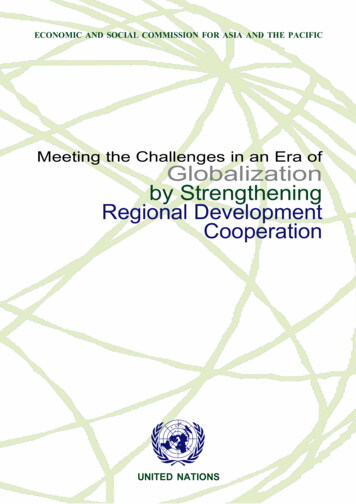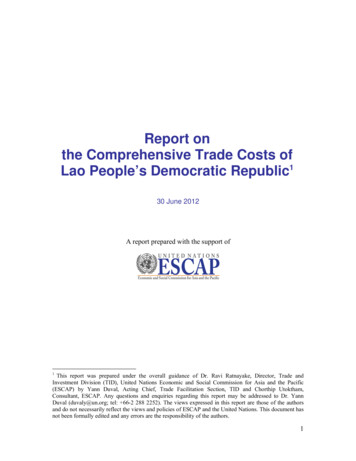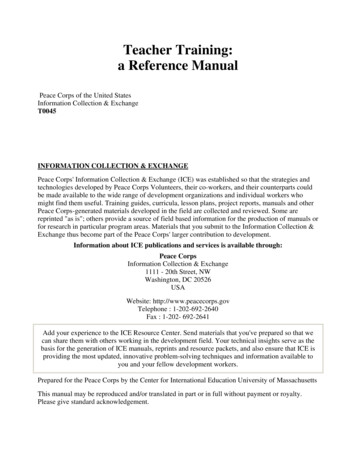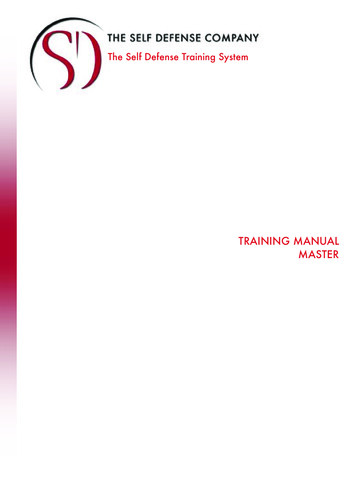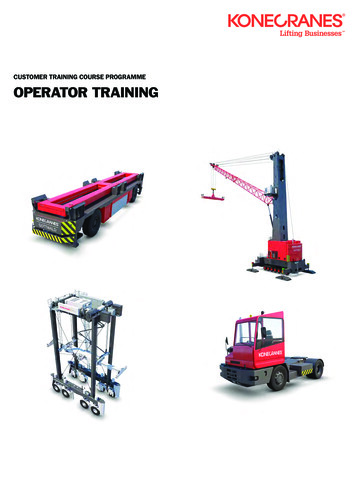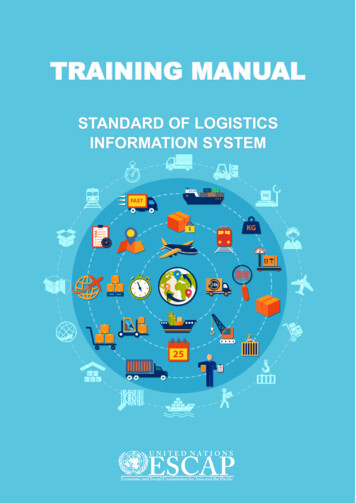
Transcription
TRAINING MANUALSTANDARDSTAOF LOGISTICSINFORMATION SYSTEMP a g e 1 41
FORWARDThe Economic and Social Commission for Asia and the Pacific (ESCAP) serves as the United Nations regional hubpromoting cooperation among countries to achieve inclusive and sustainable development. As the largestregional intergovernmental platform with 53 member States and 9 associate members, ESCAP has emerged as astrong regional think-tank, offering countries sound analytical products that shed insight into the evolvingeconomic, social and environmental dynamics of the region. The Commission’s strategic focus is to deliver onthe 2030 Agenda for Sustainable Development by reinforcing and deepening regional cooperation andintegration to advance connectivity, financial cooperation and market integration. The research and analysis ofESCAP coupled with its policy advisory services, capacity-building and technical assistance to governments aimsto support countries’ sustainable and inclusive development ambitions.The views expressed in this publication are those of the authors and do not necessarily reflect the views of theUnited Nations Secretariat. The opinions, figures and estimates set forth in this publication are the responsibilityof the authors and should not necessarily be considered as reflecting the views or carrying the endorsement ofthe United Nations.The designations employed and the presentation of the material in this publication do not imply the expressionof any opinion whatsoever on the part of the Secretariat of the United Nations concerning the legal status of anycountry, territory, city or area, or of its authorities, or concerning the delimitation of its frontiers or boundaries.Mention of firm names and commercial products does not imply the endorsement of the United Nations.This technical note has been prepared as part of the activities of the UNDA project “Transport and tradeconnectivity in the age of pandemics: Contactless, seamless and collaborative UN solutions”.ACKNOWLEDGEMENTSThe present publication was prepared by the Transport Division of ESCAP under the overall guidanceof Ms. Azhar Jaimurzina Ducrest, Transport Connectivity and Logistics Section Chief and led byMr. Edouard Chong, Economic Affairs Officer, Transport Division.Dr. Kyeongrim Ahn was the core author of the Manual. The Manual was edited by Mr. Alan Cooperand the graphic design was created by Ms. Patamaporn Leksawangwong.P a g e 2 41
CONTENTSFORWARD.2ACKNOWLEDGEMENTS .2CONTENTS .3FIGURES.4TABLES .4ABBREVIATIONS .51. INTRODUCTION .61.11.21.31.4BACKGROUND .6PURPOSE OF THE TRAINING MANUAL .6SCOPE AND LIMITATION .7CHALLENGES AND ISSUES .72. STEPWISE APPROACH FOR DEVELOPMENT OF A LOGISTICS INFORMATION SYSTEM .92.1 THE NEED TO DEVELOP A LOGISTICS INFORMATION SYSTEM .92.2 DEFINITION .92.2.1Logistics .92.2.2Logistics information .102.2.3Logistics Information System.112.3 BENEFITS OF A LOGISTICS INFORMATION SYSTEM.192.4 METHODOLOGY FOR DEVELOPMENT OF A LOGISTICS INFORMATION SYSTEM .202.4.1Goal .202.4.2Overview and steps .212.4.3Preliminary requirements for development of a logistics information system .222.4.4Details of the steps .232.4.5Example on how to analyse and define action items .253. STANDARDS RECOMMENDED FOR THE DEVELOPMENT OF A LOGISTICS INFORMATION SYSTEM283.1 OVERVIEW .283.2 RECOMMENDATIONS AND STANDARDS .293.2.1United Nations Centre for Trade Facilitation and Electronic Business .303.2.2International Maritime Organization .323.2.3World Customs Organization.333.2.4International Organization for Standardization.333.2.5Economic and Social Commission for Asia and Pacific .343.3 IMPLEMENTING A LOGISTICS INFORMATION SYSTEM (TECHNICAL POINTS) .363.3.1General requirements .363.3.2Design methodology face .373.3.6Cybersecurity.384. CONCLUSION .39QUIZ AND ANSWERS .40P a g e 3 41
FIGURES1234567891011121314Example of a supply chain, including logistics . 10Using multimodal transport, such as trucks, railways and vessels in international transport tomove cargo . 15Moving cargo using multimodal transport, such as trucks and railways in domestic transport . 17Objectives of the logistics information system . 21Methodology for implementation of a logistics information system . 21Preliminary requirements for the development of a logistics informaton system . 22Example of a project team for implementing a logistics information system . 23Detailed flow from the analysis stage to the design stage . 24How to establish an implementation plan. 24The detailed steps of the test stage . 25Example case for analysis . 26Defining a suitable approach based on requirements and challenges . 26Standards and recommendations for e-business facilitation released by the United NationsCentre for Trade Facilitation and Electronic Business. 29Implementation methodology (example) . 36TABLES1Examples of the types of logistics information systems . 132Classification of standards . 283Trade facilitation recommendations . 314Code list recommendations . 32P a g e 4 41
ABBREVIATIONSAPIApplication Programming InterfaceECEEconomic Commission for EuropeESCAPEconomic and Social Commission for Asia and PacificFALFacilitation4IRfourth industrial revolutionITCinformation and communication technologyISOInternational Organization for StandardizationITinformation technologyITUInternational Telecommunication UnionNEAL-NetNortheast Asia Logistics Information Service NetworkOASISOrganization for the Advancement of Structured InformationStandardsUN/CEFACTUnited Nations Centre for Trade Facilitation and Electronic BusinessUNNExTThe United Nations Network of Experts for Paperless Trade andTransport in Asia and the PacificWCOWorld Customs OrganizationP a g e 5 41
1. INTRODUCTION1.1 BackgroundAs the volume of international trade continues to increase on the back of such factors as economicdevelopment and trade liberalization, the importance and necessity of logistics also increases.This has become especially apparent during the COVID-19 pandemic, which has caused majorsocial structural changes globally, such as the acceleration of digitalization of communication,non-contacting of service and product provision, and unmanned and process innovation ofthe manufacturing industry. Although these structural changes were already taking placeprior to the pandemic, they were accelerated as the effects of this event took hold.From the perspective of logistics, the collapse of the global supply chain during the COVID-19pandemic brought cargo handling to a standstill, as the major elements of this logisticsnetwork, which includes ports, warehouses, terminals, or distribution centres, shut down.Furthermore, because of the labour-intensive nature of logistics, the vulnerability of logisticswas particularly highlighted in a situation in which the movement of personnel (lockdowns)was restricted. Accordingly, logistics need to cost less and be more efficient. In addition, goingforward, eco-friendly and sustainable logistics and logistics security should be emphasized.Traditional logistics transactions and the exchange of logistics data are carried out using paperdocuments, which is costly, time consuming and done manually. Greater accessibility toadvances in information and communication technology (ICT) provides an opportunity totransform the logistics information system through paperless logistics transactions. Thistransformation is highly beneficial for both the public and private sectors.Digital transformation can result in more rapid processing, better risk management and areduction in processing costs and time. Ultimately, it will result in tangible gains in productivityand competitiveness in logistics transactions and, in cases in which information-sharingamong stakeholders are made across borders, the potential benefits can be even higher.Users of a logistics network are hoping to reap the benefits of this transformation. Accordingly,digital transformation in the logistics industry with digital technology needs to be acceleratedto address user requirements and to cope with unexpected events, such as the COVID-19pandemic. This entails deploying the latest technologies, such as robots, artificial intelligence,and big data, in developing digital transformation strategies. Under this scenario, the need forlabour declines and productivity increases.In other words, digital transformation or logistics informatization that combines informationtechnology (IT) into a logistics business is an essential requirement for improving logistics.1.2 Purpose of the training manualThis training manual was developed as part of a project covering short-term responses totransport and trade connectivity during a pandemic. Lessons learned from the COVID-19P a g e 6 41
outbreak were used to guide governments and businesses in developing a logisticsinformation system with the objective to carry out digital transformation or logisticsinformatization.Included in the training manual are definitions of logistics, logistics information and a logisticsinformation system, a description of a of logistics information systems, a stepwise approachon how to develop a logistics information system and a list of required standards to implementsuch a system.The training manual is intended to support Economic and Social Commission for Asia and thePacific (ESCAP) member States in their efforts to develop logistics information systems usingstandards to improve work productivity and efficiency in a sustainable way.1.3 Scope and limitationThe logistics environment is going through rapid changes in line with advancing technology.Many stakeholders are keen to change the way they exchange logistics information at bordersto support transport connectivity, but they still continue to rely on exchanging paperdocuments using a paper format, which is time consuming and inefficient. This alone presentsthe case to implement a logistics information system and exchange electronic data with othercountries through digital transformation and connectivity.The Economic and Social Commission of Asia and the Pacific is positioned to support the digitaltransformation to build a logistic information system by providing relevant information andconsultations. One example of this support is the present guide.Before going further, it should be noted that the standards and considerations presented inthis training manual are general concepts and strategies according to ESCAP requirements,which can be altered over time to adapt to changing conditions.1.4 Challenges and issuesMost countries have introduced some form of automation and informatization to improvetheir logistics procedures and operations and build their overall capability, however, in general,these efforts have been limited. To carry this effort further, they are likely to face the followingchallenges: Large Information gap among member States because of the high percentage ofmanual processing, in particular, for processing paper documents;Insufficient linkage of information systems among member States;Absence of information exchange among member States;Limited compatibility and standardization;Difficulties in finding or accessing required information.The logistics industry, including transport, is becoming more sophisticated and competitive,requiring logistics information systems to be resilient and sustainable, have interoperability,and can share information with other information systems.P a g e 7 41
This training manual includes a review of the “logistics, logistics information and logisticsinformation system” concept, and a comprehensive guide for implementing such a system. Itis ultimately aimed at providing technical consideration and the referenced standards forESCAP member States to apply or refer to when developing their own logistics informationsystem.P a g e 8 41
2. STEPWISE APPROACH FORDEVELOPMENT OF A LOGISTICSINFORMATION SYSTEM2.1 The need to develop a logistics information systemAs the trade and transport environment diversifies and evolves globally, the importance oftransportation and logistics increases. Notably, many changes in the supply chain haveoccurred in line with advances in technology during the fourth industrial resolution (4IR).Digital transformation is inevitable in global supply chains to respond to these changes.Furthermore, the COVID-19 pandemic has rapidly shifted consumers' purchasing patternbehaviour to shopping online, forcing changes in transport and logistics to respond to the newcondition.The complexity of the logistics system is increasing. Some of the factors behind this are theneed to accommodate the increasing cargo volume, reduce transportation and handling time,and adapt to multi-transport or intermodal transport.Keeping transport and logistics competitive is an important factor. This is determined by notonly a single organization, but also by an industry and a country. The development of IT is amajor innovation for logistics management and has become a major factor in thecompetitiveness of a logistics system.To date, the focus has been mainly on the expansion of hardware-centred social overheadcapital for logistics management or improvements to a logistics system. Going forward,greater emphasis will be placed on the transformation of a logistics information system tomake it more efficient and be able to systematically manage logistics information.Accordingly, it makes sense to develop a logistics information system to improve efficiency inthe transport and logistics sector, with the objective to facilitate interoperability andscalability using standards. In other word, applying international standards is a prerequisitefor development of a logistics information system.2.2 Definition2.2.1 Logistics1The global technology media company TechTarget defines logistics as the process of planningand executing the transportation, storage, loading/unloading, transshipment of cargo from itsorigin to final destination. It explains that the objective of logistics is to address requirementsof users, such as exporters, importers, freight forwarders and carriers, and or the relevant1David Essex, “Logistics”, TechTarget. Available at ics.P a g e 9 41
organizations, such as port authorities, railway authorities and customs agencies, in a timelyand cent red effective manner.Figure 1Example of a supply chain, including logisticsSource: Downloaded image by the author using free images.Some of the major functions of logistics are transportation, warehousing, loading/unloading,stuffing. Among the stakeholders in the related supply chain are consignors/consignees,freight carriers, freight forwarders, customs brokers and terminal operation (figure 1).Transportation, one of the main components of logistics, implies moving cargo from it placeof origin, such as manufacturers, warehouses, or terminals, to its destination, the ultimatereceiver of the cargo. Cargo can be transported by sea, air, railway, or road, or throughmultimodal transport.2.2.2 Logistics informationLogistics information is information generated through the whole supply chain, including, forexample, transportation, storage, loading/unloading, packaging and distribution. Morespecifically, it is the following:P a g e 10 41
Information generated on logistics activities, such as transport, packaging, unloadingand storage;Materials that give value to a specific user for a specific purpose, present or future, ina specific situation.In other words, valuable logistics information is accumulated while performing the mainfunctions of logistics, such as transport, storage, unloading, and packaging, which are majorphased activities of logistics management. The accumulated data, if well organized andanalyzed, can be a valuable resource for logistics management.Accordingly, logistics information can be used to recognize and evaluate the current status oflogistics activities and determine the future direction based on this, and will contribute to theachievement of logistics goals by promoting cooperation among participating parties.Logistics information is generated from various subjects, such as a business entity’s system,and Internet of things devices, in any place or any time, which, as a result, gives it a widescope. Another important characteristic of logistics information is consistency, as there maybe a time difference between cargo flow and information flow because cargo moves a atdifference pace than information flow.The United Nations Centre for Trade Facilitation and Electronic Business (UN/CEFACT), anintergovernmental body that serves as a focal point for trade facilitation, explains that thelogistics information process involves the management of shipping, which is closely relatedto the management of information flows relevant to logistics., It also clarifies that themanagement of logistics information processes and systems vary, depending on the sectorsand type of goods involved.2Accordingly, the management of a logistics information system encompasses all itssubsystems, such as cargo collection, delivery, transport, storage and loading and unloading.2.2.3 Logistics Information System2.2.3.1 DefinitionA logistics information system is an information system that enables efficient logisticsmanagement by organically combining all logistics functions, such as transport, storage,unloading and packaging, that constitute logistics activities. It, therefore, supports allfunctional areas of logistics, such as transportation, delivery, warehouse management andorder management, and works closely with the activities of corporate management.The role of a logistics information system is as follows:3 23Provide logistics information on goods and follows their delivery path, progress andstatus;Provide logistics information-sharing with external logistics information systems;Adopt international standards to comply with regulations, and use standardized waysSee on-process.htm.Ibid.P a g e 11 41
of exchanging logistic information with other systems and with authorities.In addition, the logistics information system carries out the following functions: Monitors the actual products and articles to know whether they will arrive on timeand in proper condition at the delivery destination, and if it will be possible to takeprompt action when incidents occur;Monitors the progress and status of the transport means and the transport equipment;Detects incidents or delays involving logistics activities, and alerts or reports them tomanagers or clients.2.2.3.2 Considerations for introducing the logistics information systemLogistics activities are carried by various organizations, including, among them,enterprises, carriers, distribution centres, wholesalers, retailers and customers.Accordingly, the logistics information system should be planned with the intention toimprove the quality of service and reduce logistics costs, while taking into considerationthe effects on the environment and the characteristics of the entities involved. In addition,to facilitate the flow of logistics information and minimize the overall logistics cycle, theoptimization of the logistics network and interoperability between information elementsshould be considered.For a logistics information system to actively respond to internal and externalenvironmental changes, a standard code, which is the most basic element of aninformation system, standard interfaces and data standards must be defined to enabledata compatibility between related subsystems. Moreover, as global trade and logisticsexpand, interworking with external systems is essential. Consequently, in terms ofinteroperability, logistics information systems must be developed by applying standards.The design of a logistics information system should be based on the organization’s goalsand short- and long-term strategies by considering the complex factors that would affectsuch a system. In addition, the logistics information system must be flexible so that it canrespond to user service demands during the system construction process.Finally, to fit in with specific characteristics, a logistics information system needs to thehave capacity to accommodate the following: Huge volume of informationLarge gaps in the transmission of between peak times and normal timesWide distribution of the source of informationConcurrency of cargo flow and the logistics flowHigh relevance with other industry sectors, such as customs and tradeIn addition, it is necessary to consider the following when designing a logisticsinformation system: Ensure real-time processing in terms of the time of information occurrenceLinkage and interconnectedness between systems so that information can bereusedP a g e 12 41
The physical flow of cargoEmphasis on the work management planBeing able to provide predictive services based on accumulated logisticsinformation2.2.3.3 Types of logistics information systemsThere are many types of logistics information systems; among them are transport meansmanagement, transportation management, cargo management, facility (equipment)management, and warehouse management. Table 1 shows an example of classifying thelogistics information system by means of transport that moves cargo.Table 1Examples of the types of logistics information systemsSeaLandRailwayConnectivity Vesselmanagement CargoManagement FacilityManagement Crewmanagement Transportmanagement Terminaloperation Containeryard/containerfreight stationmanagement Warehousemanagement Drivermanagement Freight Carmanagement Freight wagonmanagement Cargomanagement Facilitymanagement Crewmanagement Port communitysystem Single Window Cargo tracking InformationsharingWhen classifying the kind of logistics information systems referred to in table 1, logisticsinformation systems in terms of transportation means and transport management may exist,including, for example, vessel management by the sea, transport management on land, freightcar and wagon management in a railway side and airline management.A terminal operation system, a logistics information system for terminal operation at a road,is used to control and monitor the movement and storage of various types of cargo in andaround the container terminal, port or inland depot. 4 In road transportation, thetransportation management system for transport management assists in meeting thedemands of transport-related logistics and supports the planning and executing of thetransportation of the shipment and optimizing the route of the shipment.Another logistics information system on the road is a yard management system, which isdeveloped to manage the movement of trucks and trailers at a manufacturing facility,warehouse or distribution centre, and to plan a container loading/unloading position to4Thomas Ward, “Terminal operating system” selection, Port Technology (2013). Available terminal operating system selection/P a g e 13 41
optimize the loading/unloading time.Finally, the role of a warehouse management system is to help control and manage warehouseoperations from the time goods or materials enter a warehouse until they are sent out in themost efficient and cost-effective way. Some of the prominent features of warehousemanagement systems are inventory tracking, picking and packing goods, shipping, and yardand dock management.Case study of how to determine the required e logistics information systemfor moving cargo by transport meansCase 1. Cargo moving from exporter to importer by multimodal transportation (figure 2)1. Define workflow and the participants: refer to the black arrow in figure 2; Define the interface, electronic messaging, process modelling and other facets; Define the role of each participant.2. Consider which type of logistics information system is needed at the defined workflowfrom the participant’s roles (refer to the blue box (system) and green star (functions) infigure2) Exporter: warehouse management system, order management and others, Carrier: transportation management system; Terminal: terminal operation system (including yard planning); Port authority: port management system, inspection; Customs: customs declaration system, manifest system, inspection and others; Shipping company: vessel planning system.3. Consider whether to develop the logistics information system inhouse or use a solution. Carriers should either implement a transportation operation system or use asolution. Terminal operators should either implement a terminal operation system or use asolution.Quiz question 1.Assume you are a terminal operator.Which logistics information system is needed for a terminal operator? (Answer:) transportation management system warehouse management system terminal operation system yard management systemP a g e 14 41
Figure 2Using
The training manual is intended to support Economic and Social ommission for Asia and the Pacific (ESAP) member States in their efforts to develop logistics information systems using standards to improve work productivity and efficiency in a sustainable way. 1.3 Scope and limitation
